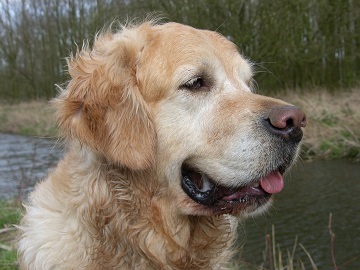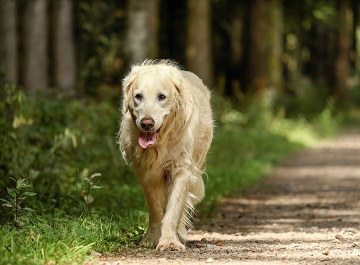Unfortunately, hip dysplasia and Golden Retrievers is the most common medical problem that Goldens get.
Over 21% of Golden Retrievers will experience some level of hip dysplasia. The Universities Federation For Animal Welfare has reported that in the United States that that number could even be as high as 73% of Golden Retrievers.
For some Golden Retrievers, hip dysplasia will be very painful, but many Goldens will be able to function quite well for most of their life with relatively low amount of pain.
In many cases it can appear worst for them as they are young and also as they become senior dogs.
Table of Contents
What Is Hip Dysplasia
Hip Dysplasia is an excessive laxity in the rear joint or an excessive shallowness of the hip socket joint.
The ball in the hip socket will move too much within its socket. As the years pass, your Golden Retriever with hip dysplasia will start to experience painful arthritis in their rear hips as they age.
An easier way to understand what is happening might be this. The dog’s hips do not develop normally and the ball doesn’t fit snugly into the socket.
Most times it is an inherited instability of the dog’s joints.
Some Golden Retrievers will start showing signs of having hip dysplasia as early as 4 months old, while others might develop it as they age.
Why Do Golden Retrievers Get Hip Dysplasia
There is some debate as to why Golden Retrievers get hip dysplasia. A large portion of Goldens that get hip dysplasia is from a genetic factor that is causing the issue.
Most breeders will have their dog’s hips rated by an orthopedic group, because so many Golden Retrievers have problems with hip dysplasia. This will give you the reassurance that your dog won’t have a genetic hip dysplasia.
There are also environmental reasons that your Golden Retriever could end up with hip dysplasia. Over or under exercising a puppy during his growth phase can cause your puppy to develop hip dysplasia.
Your dog’s weight and nutrition can also play into getting hip dysplasia.
Large breed puppies need food that is specially designed for their needs. This food needs to make sure that your puppy doesn’t grow excessively too quickly, which can lead to skeletal disorders such as hip dysplasia.
Signs Your Golden Retriever Might Be Suffering From Hip Dysplasia
There are several things that you can watch for to help you determine if your dog is suffering from hip dysplasia, but the only conclusive way to know if your dog has hip dysplasia is from your veterinarian taking an X-ray of your dog’s hips.

Watch how your dog walks for clues for hip dysplasia
- Bunny Hop – Many Goldens with hip dysplasia will do a bunny hop. They will use both hind legs together, rather than one at a time when they are running or going up stairs.
- Lazy Sit Or Slouch – You might notice your dog sits real lazy or has a slouch. Their legs are real loose and off to one side instead of directly underneath their butt.
- Loose Walk – Their back end sways back and forth when walking because their hips are loose. Their legs will almost look wobbly when they are walking.
- Laying With Legs Straight Behind – Most dogs will sometimes lay with their legs straight behind them, especially when they are puppies. But if your dog mainly lays with his legs straight behind him especially as they are getting older, it could be a sign that your dog his hip dysplasia.
- Limping – Dogs with hip dysplasia tend to limp. They will even change the limp from side to side, or one day it might be the left side limping and the next day it is the right side limping.
- Don’t Jump On Furniture – You will notice that a dog with hip dysplasia don’t actually jump on the furniture. They will pull themselves up by their front end, rather than using their hind legs to boost them up.
- Underdeveloped Hind Quarters & Overdeveloped Chest – This will be caused by not using their hind legs normally and relying more on their front legs to do the work.
Nonsurgical Relief For Hip Dysplasia
There are some options to help your Golden Retriever with hip dysplasia other than surgical. This will also depend on how severe your dog’s symptoms are, but I would consider surgery the last resort. Here are some ways to help manage the pain your dog experiences from hip dysplasia.
- Weight Reduction – This will help reduce the amount of stress on your dog’s hips.
- Exercise Restrictions – Don’t over push your dog with exercise. It would be better to give them exercise more often for shorter periods of time.
- Physical Therapy Or Chiropractor
- Supplements
- Acupuncture
- Anti-inflammatory Medications – There are ones your veterinarian has available, several over-the-counter anti-inflammatories, and many dog owners have stated they have had success giving their dogs CBD Oils to help with the pain. CBD Oils have also been reported to help prevent cancer in dogs and help with anxiety.

Loose legs when sitting or slouching could be signs of hip dysplasia.
Surgical Options For Hip Dysplasia
Juvenile Pubic Symphysiodesis – This is performed on puppies under 20 weeks old. It is a preventive measure that alters the pelvic growth. It has a short recovery, but it is generally done before your puppy is even diagnosed with the problem.
Dorsal Acetabular Rim – The veterinarian will do a bone graft to build up the rim on the hip socket.
Triple Pelvic Ostomy – The veterinarian will cut bone around the hip socket and reposition the socket for a better fit. This would be performed on young dogs before they are done growing.
Total Hip Replacement – Very similar to humans getting a hip replacement. It would be done on mature dogs.
Femoral Head Ostomy – This would be the removal of the femoral head of the leg bone to eliminate the pain. The scar tissue that develops will create an artificial hip joint.
If you choose the surgical route, your veterinarian would know which procedure is best for your dog’s situation.
Goldens Living With Hip Dysplasia
Let me give you some personal experience of Golden Retrievers with hip dysplasia so you realize it isn’t impossible to manage.

Goldens that regularly lay with their legs back could have hip dysplasia
I got 2 Golden Retriever litter mates several years ago. One of them we realized fairly early that he seemed to have problems. The veterinarian wanted for him to have surgery right away. We decided against the surgery.
He did limp if we walked too far, his chest and front was overdeveloped and he would pull himself up on furniture instead of jumping up. He always seemed very stiff when getting up and when walking. But he managed very well. I did give him anti-inflammatories for many years, and he did OK.
We just were always very conscious that he couldn’t do as much.
On the other hand, the other Golden Retriever we thought he was a spring board. He could jump on anything and could run forever. At the time, we didn’t realize that he also had hip dysplasia, because he seemed like a rubber band.
What we didn’t realize when he was young was that he almost always laid with his back legs straight behind him and that was a signal that he could also have hip dysplasia. He has led a very active life, could run forever and never had problems jumping up on anything.
He now does have hip dysplasia, but he is now over 11 years old and it has been only recently that it has affected him. He has very wobbly legs when walking. It almost seems like they are loose in the socket when he walks. He has lived a very full happy life, and had no issues until recently.
I just want you to see, that it is something that is manageable, and you can have great Goldens even with hip dysplasia.
Summary
At some point in their life, hip dysplasia and Golden Retrievers are a very likely possibility, but it is something that you can manage and help them with hip dysplasia. It is best to be informed ahead of time and know what to watch for with hip dysplasia.
That will make you better prepared if you need to make some adjustments with your Golden Retriever’s life with diet, exercise or weight control.
Discuss with your veterinarian what your best course of action should be with your Golden Retriever.
I have to say that the love, friendship, and great companionship makes it still worth having a Golden Retriever, even with the risk of them getting hip dysplasia.
If you would like more information on Golden Retrievers in general, you can either check out male vs female Golden Retriever or what you should know about Golden Retriever puppies.
If you have any questions or comments, please leave them below. You can follow justforyourdog.com on Pinterest, FaceBook or Twitter for all the latest updates about dogs.
Some of the links within this post are affiliate links of which I might receive a small compensation from sales of certain items.
My Golden is 12 years old & having trouble getting up with one of his hind legs, please send me any advice
Reply
If you don’t have your dog on some type of joint supplement, I would get him on it right away. My Golden is also 12 years old and he was barely able to get up off the floor until I got him on a joint supplement. I put him on Nutramax Dasuquin and it has helped him greatly. Take a look at dog joint pain relief.
I would start with that, and if that doesn’t help your dog enough. I would recommend contacting your vet. They can prescribe Carprochew, which has a stronger dose of relief, but will cost you about $120 per month.
Reply